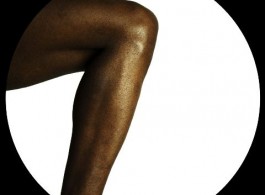Curated by Susanne Junker
[Press Release]
For over two thousand years, many artists have been inspired by The Last Supper, Christ’s last meal during which the son of God delivered his testament. There are thirteen people at the table, as if in a perfectly staged play. With ” …Do Not Take It, Do Not Eat It, This Is Not My Body… “, the Cameroon artist is showing us some sort of anti-Last Supper. A secular proposal in which God, in his Judeo-Christian conception, is absent. The event, or perhaps it would be best to use the word “show”, which doesn’t correspond to the theme at all, takes place in two stages. We could describe it as a diptych.
On the one hand, there is a purely formal element: a bead curtain which, borrowing from the Léonard de Vinci tableau, represents a sketch, an abstract projection, presenting us with an empty table. Christ and his apostles appear to have deserted their places and we are left to wonder if it is primarily a temporal experience. The table is empty as if it is enough in itself. As if it doesn’t matter if the meal took place before or after. It is up to us to fill the haunted void. This void, which we know represents the very essence of all spirituality: the omnipresence of absence. Absence as impossible idealisation, absence as a grip that is never lost and which will remain a memory. A naturally truncated memory since only our despairing determination convinces us that there is something to see. Absence as the symbol of a new epiphany.
This tableau’s counterpart is a lively and carnal scene (the word is used deliberately). A moment of physical presence, which the spectator is invited to look at. In this lively tableau, it is the meal, and not its abstraction, which marks the curtain’s counterpoint. The curtain, in its principle function, is reduced to a decorative element. A decorative element overdetermining that the performance will try to contradict by playing, not on the reference but on its contestation. The human becomes the centre of every possible realisation, and the device as a whole represents this part of the painting, which is so dear to the artist. Again, the meal itself is not the objective. It is all in the process. The long road leading to the final supper. There may be no supper. As in the curtain, we are invited to imagine the time before and afterwards. However, since the performance is the aesthetic and conceptual contradiction of the curtain, the spectator has the privilege of seeing that which cannot normally be seen, and will later say, as Rimbaud did, that they have seen, several times, that which man believes he has seen. This carnal moment, this moment of life, in the main sense of the term, undoubtedly holds the key to the riddle presented by the title of this moment. It depicts the age-old battle between God and men.
This ontological experience, which combines the secular and the sacred whilst humanising concepts that have been lost, by dint of its meaning being mechanically repeated, reminds us that sharing, in its simplicity and spontaneity, is what makes humanity. A reminder which is greatly appreciated in these troubled times.



